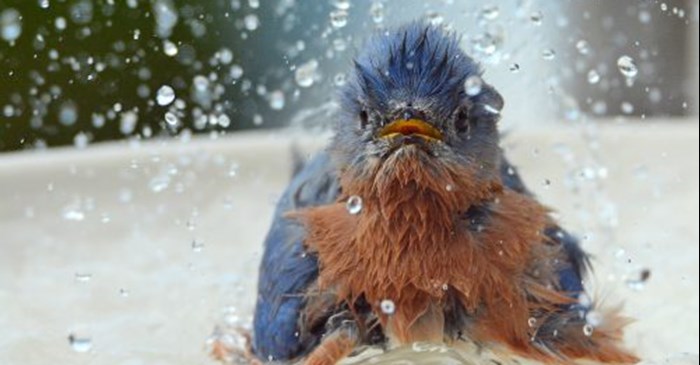Once you’ve got feeders set up, perhaps the best way to make your backyard more attractive to birds is to just add water.
Birds need a dependable supply of fresh, clean water for drinking and bathing. Putting a birdbath in your yard may attract birds that don’t eat seeds and wouldn’t otherwise come to your feeders.
Traditional concrete birdbaths sold in garden shops make nice lawn ornaments, but they aren’t the best type for birds—they’re often too deep, glazed ones may be too slippery, and they’re often hard to clean. Also, they may crack if the temperature drops below freezing. The best birdbaths mimic nature’s birdbaths—puddles and shallow pools of water in slow streams; they’re shallow with a gentle slope so birds can wade into the water. Look for one that won’t break and is easily cleaned.
You can make your own birdbath using a trash can lid, saucer-type snow sled, shallow pan, or old frying pan.
Setting up your birdbath
Birds seem to prefer baths that are set at ground level, where they typically find water in nature. While birds are bathing they can be vulnerable to predators, especially to cats. If you have a cat, please keep it indoors. If cats are at all likely to be lurking in your neighborhood, make sure there is a fairly wide open area between your birdbath and the nearest thick shrubbery, so birds have a better chance to detect and get away from a cat in time.
Place your birdbath in the shade if possible, to keep the water cooler and fresher. Having trees nearby will also provide branches on which they can preen.
Arrange stones (or branches) in the water so birds can stand on them to drink without getting wet (this is particularly important during freezing weather).
The water should be no deeper than 0.5 to 1 inch at the edges, sloping to a maximum of 2 inches deep in the middle of the bath.
One of the best ways to make your birdbath even more attractive is to provide dripping water. Many birds find the sight and sound of moving water irresistible. You can use a commercial dripper or sprayer, or make your own by recycling an old bucket or plastic container. Punch a tiny hole in the bottom, fill it with water, and hang it above the birdbath so the water drips into the bath.
Maintaining your birdbath
When the temperature is above freezing, it’s a good idea to keep your birdbath full at all times to attract the widest numbers and variety of birds. But to provide a safe drinking and bathing environment, it’s important to change the water every day or two. Bathing birds may leave behind dirty feathers and droppings, making the bath increasingly unsanitary for other birds.
For more information, please see The Cornell Lab of Ornithology free PDF download, BirdNotes—Providing Water for Birds.
Republished with permission from The Cornell Lab of Ornithology
